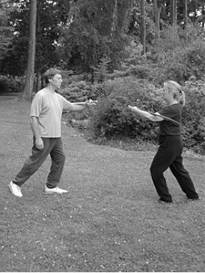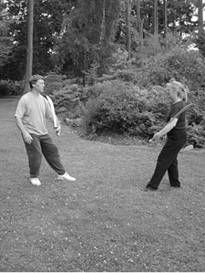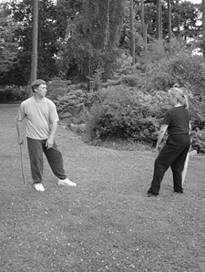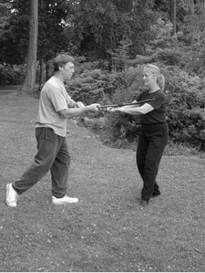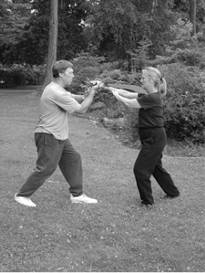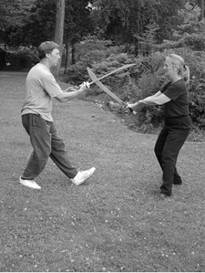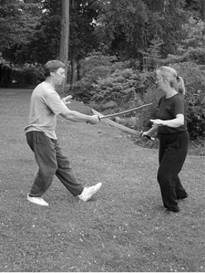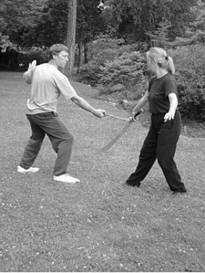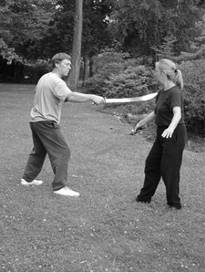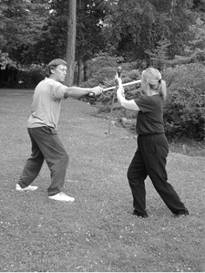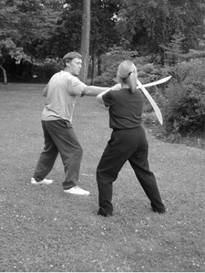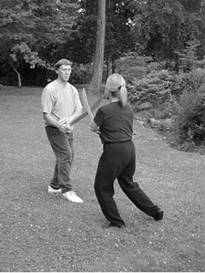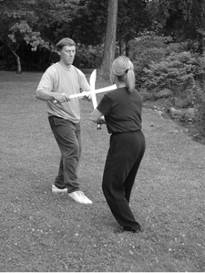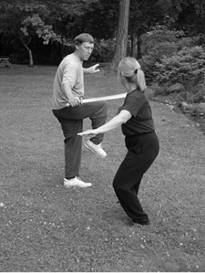 Gilman Studio On-Line Lessons
Gilman Studio On-Line Lessons
Yang Style Saber Application Form
Tai Chi Chuan
This Lesson Contains:
The Whole Form
This is a wonderful point in our lessons. We have finished examining the form, piece by piece, and now we look at how it all fits together. If you don’t have a training partner yet, I’m sure you will feel stimulated to go out and find someone you can learn this with. It is a fun form with lots of lessons. As you progress in your practice, the form goes faster and faster, until it becomes almost a blur. You must at all times remain conscious and aware of what you are doing so nobody gets hurt. One slip and there may be life long injury, especially in the eye area.
Special Message: There is a companion video now available to compliment this course. It will make learning and practicing this form much easier. Just go to my on-line store. As always, I really appreciate your interest. Also, if you haven’t yet looked at the Yang Saber Class at my site, I think you would enjoy it.
Please be patient as this lesson downloads. It has quite a few pictures and will take a while to fully load.

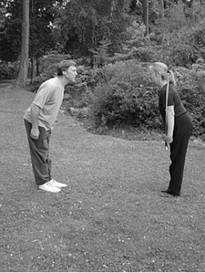 Michael, on left, is A and Stephanie, on right, is B. For ease of breaking down the form into directions, we will call Michael’s starting direction north and Stephanie’s south.
Michael, on left, is A and Stephanie, on right, is B. For ease of breaking down the form into directions, we will call Michael’s starting direction north and Stephanie’s south.
1) Partners face each other at a distance slightly further than one saber length.
2) Bow to your partner.
1) Both step back with the right foot, touching the toe first. Be sure to keep a wide base of support. The left hand containing the saber starts to circle up and around in front of the body.
2) Shift the weight back onto the right foot. The saber has completed the circle and is now by the left hip. The right hand starts to receive some peng jing.
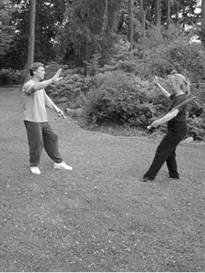
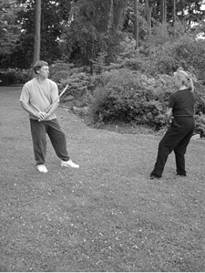 1) Salute the partner is complete. Both people are in empty stance on left toe. The right hand is raised in front of the body at head level. The saber hand has peng jing. Both focus on the partner. For those of you who know the solo form, Salute is actually Retreat to Ride the Tiger.
1) Salute the partner is complete. Both people are in empty stance on left toe. The right hand is raised in front of the body at head level. The saber hand has peng jing. Both focus on the partner. For those of you who know the solo form, Salute is actually Retreat to Ride the Tiger.
Changing Saber hand.
2) Turn the waist to the right, drop the right hand, bring the saber over to the right, and pass the saber to the right hand.
1) Drop the saber point and let the right arm hang down slightly behind the body. Keep the body turned to the right. Both are still in empty step on toe. Focus on the partner.
A – Chop the neck
2) A starts to swing the saber around the head as he replaces the left foot. The heel just touches and the toe faces the left corner (northwest).
B waits to see what A is going to do.

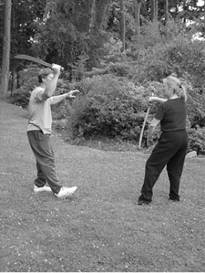 1) A shifts the weight onto the left foot and rolls up onto the right toe as part of his step forward. The saber continues to swing around the head to gain momentum for the chop to the neck.
1) A shifts the weight onto the left foot and rolls up onto the right toe as part of his step forward. The saber continues to swing around the head to gain momentum for the chop to the neck.
B waits patiently.
2) A steps forward with the right heel. The toe faces north. Be sure to step wide enough to provide a solid base of support. The saber starts to chop down.
Since A is committed to the chop down, Bstarts to raise her saber to protect.
B – Chop the wrist
1) A completes the chop to the neck by shifting the weight onto the right foot and chopping down with the saber.
B has stepped to the side with her right foot in a cross step to avoid the chop, and brought up her saber to block if necessary.
2) B now starts to attack A’s wrist by shifting the weight onto the right foot and turning her body to the left. The saber is swinging around her back and is hidden from A’s view.
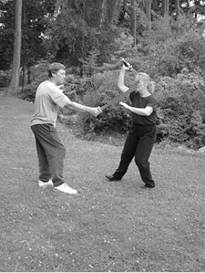
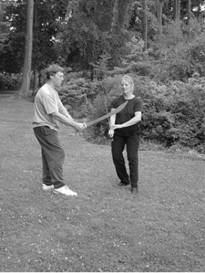 1) B steps in with the right foot. The saber has finished the circle around the head and is starting to chop down toward the wrist. She is focusing on the target.
1) B steps in with the right foot. The saber has finished the circle around the head and is starting to chop down toward the wrist. She is focusing on the target.
A starts to withdraw his saber and shift his weight back to get out of the way.
2) B has finished her chop and A has withdrawn his saber and is now in empty stance on toe. Both are relaxing their focus to see what is going to happen next. A faces north and B faces west.
B – Pull Level Knife
1) B sees the upper level open so she starts to step in using a side step with her left foot. She is focusing on the target and sticking or being aware of A’s saber.
A starts to retreat by stepping back with the right foot, touching down the toe , to get out of the attack. If possible, he is sticking to B’s saber as she attacks up.
2) B’s attack is complete. She has shifted onto her left foot. The saber is at neck level.
A has stopped the attack using his guard. Notice that his guard is a good distance away from his body to give him room to maneuver. He is in left foot Bow stance. A’s focus is on guarding.
B – Thrust Knife
1) A’s center is open so B starts her attack to this level. She replaces her left foot (in the same place, or to the left some) in order to find the correct opening. She starts to draw her saber down to her waist level so it will be in a good position to thrust out with power.
A shifts the weight back onto the right foot. He sticks and follows B’s saber.
2) B continues by shifting the weight onto the left foot, freeing up the right foot to step in. Her saber is now in position to thrust.
A continues to stick to B’s saber and waits to see what her next move is going to be.
Both are focusing on sticking while B also keeps some focus on the target.

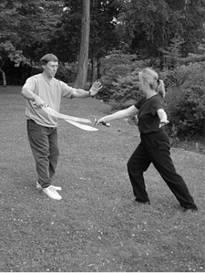 1) B steps in with her right foot. Her saber hasn’t started the thrust yet.
1) B steps in with her right foot. Her saber hasn’t started the thrust yet.
A steps back at the same time that B steps in. Be careful to step back wide enough to provide a solid base of support.
It is important for both people to stick at this point. A could easily flick upward with his saber if B forgets about defense at the expense of her attack.
2) B thrusts out her saber by shifting her weight forward and bringing the energy up out of her left Kua.
A follows the thrust by sticking and leading B’s saber to his right as he shifts his weight back onto the left foot and turns his torso to the right. His left hand threatens or distracts.
B focuses on the target while A focuses on sticking and leading.
B – Side Step.
1) Having lead B’s saber past him to the right, A steps in and starts to thrust to B’s ribs.
B starts to recover and regain her center by pulling back.
2) A thrusts by shifting the weight onto the right foot and releasing the stored energy in the left Kua. Notice that he had to make a bit of an arc around B’s saber to get at her ribs on her right side.
B shifts the weight back onto the left foot and side steps with her right foot across to the left to avoid A’s thrust. At the same time she presses down with her guard on A’s saber blade.
A focuses on the ribs and B focuses on side stepping and pressing down.
B – Spiral to the Right
1) As B starts to step around and in, Astarts to poke upward to her neck. All he does is turn his torso to the right and bring the saber up.
B starts to bring her saber up by her right side in order to be ready to chop when she gets in a good position. At the same time she is shifting her weight onto the right foot so she can free up the left foot to step in.
2) A finishes his poke. Be sure to rotate the saber when bringing it up so the cutting edge is facing outward.
B now has all her weight on the left foot and rolls up onto her left toe. Her torso is turning to the right.
Her saber is up for the block of her neck area. The left hand supports her right wrist to provide stability.
A focuses on the target. B focuses on her block.
B – Chop to the Wrist
1) B, having spiraled in, is now in good position to chop the wrist. She has stepped forward with her left foot, and starts her chop as she shifts her weight onto the left foot. Her body faces to the south west.
B focuses on A’s wrist.
2) A withdraws his body into empty step on right toe and pulls his saber down and in by his right hip as B chops down. His torso turns to face B. He faces north east. The sabers are joined together and both people stick.
A focuses on withdrawing and sticking with his blade. B’s focus is in her center.
B – Cut to the Neck
1) As A withdraws into his center, B goes up to the neck. She sinks her weight deeper into her left leg and rolls up onto her right toe in preparation to step in. She continues to face south west.
2) B steps in with her right foot and starts to shift the weight onto the leg. As she shifts, she brings her saber up to cut the neck.
A sticks and follows her saber upward.
B focuses on the target. A focuses on sticking.
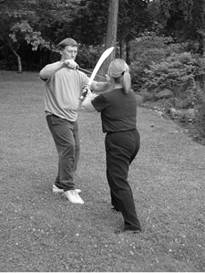
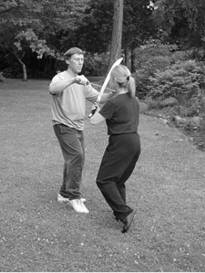 1) B finishes her neck cut and is fully on the right foot. Her saber is extended outward with the blade in an arc position with the tip more to the right than the handle.
1) B finishes her neck cut and is fully on the right foot. Her saber is extended outward with the blade in an arc position with the tip more to the right than the handle.
A, sticking, has brought his saber up in a diagonal across his upper body to block. Be sure to keep your shoulders relaxed.
A focuses on sticking. B focuses on the target.
A – Ride the Tiger and Cut Wrist
B – Slice the Knee
2) As A brings his saber up to block, Bdecides to go low. Here she replaces the left foot in preparation for getting back to make room for her slice.
Both people focus on relaxing.
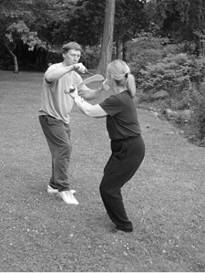
 1) B, having replaced the left foot back, starts to shift her weight onto this leg. At the same time her saber is starting to make an arcing cut down toward the knee.
1) B, having replaced the left foot back, starts to shift her weight onto this leg. At the same time her saber is starting to make an arcing cut down toward the knee.
A starts to bring his saber down to be in position for whatever happens next.
B focuses on getting back. A focuses on energy relaxed in his center. The body positions remain unchanged.
2) B continues her slice to the knee. Notice her weight stays back to keep out of A’s range.
A sees the slice coming. He starts to get his right knee out of the way to the left. His saber is starting to attack B’s wrist.
B focuses on the knee. A focuses on getting his knee out of the way and on B’s wrist.
B finishes her cut and then withdraws her body back into her center (see transition lesson). She immediately follows with Chop to the Neck (side A).
A gets his leg out of the way and cuts to the wrist. As B withdraws and follows with her Chop, he steps to his right, inside, and Cuts to the Wrist (side B).
Note: When you want to finish your practice: The Ending
1 – A Side) Following this position, A puts his right foot down to his right so it ends up shoulder width and parallel to his left foot. Do not shift the weight onto the foot yet. As he steps down, he places the saber into his left hand, leaving the right hand touching the left hand. The hands are by the left hip. As he shifts the weight onto the right foot, the two hands make a large clockwise circle in front of the body. By the time the weight is fully on the right foot, the two hands have circled around and down to the right hip area. The weight then shifts to the left foot, bringing the two hands to the left hip. The right hand then disengages and continues to circle on its own as the weight is centered. It ends by the right side.
2 – B Side) B does the same movements as A. Step right and change hands, circle and shift the weight right, shift left and then release the right hand, center and finish by bring the right hand down.
This is the same ending as the solo form ending. Refer to that lesson for further clarity. In any event, the two players should return to their original directions, facing each other. Bow, and take a moment to let the energy return to normal.

